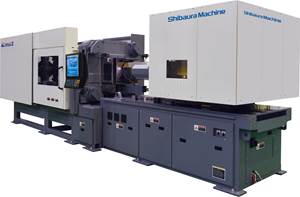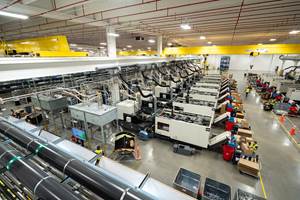Word Games: What’s a ‘Hybrid’?
Any molder will tell you there’s a difference in working with electric vs. hydraulic drives. Servohydraulic is still hydraulic; a hybrid machine is something different. Imprecise use of terms causes needless confusion.

A true hybrid: This press has electric screw drive and hydraulic clamp. (Photo: Matthew Naitove)
Words are an editor’s tools of the trade. Like any tools, they must be used properly. As a newcomer to plastics when I started at this magazine in 1972, I received the necessary instruction from my first boss, managing editor Lowell Scheiner. He taught me the crucial distinctions between technical terms he said were often confused or misused.
Examples: Activate refers to chemical or electrical excitation of a substance; actuate means to initiate movement or mechanical action of a machine
To plasticize is to cause a polymeric material to become more soft and flexible through addition of a chemical substance — a plasticizer. (Formulators of vinyls and many other compounds are intimately familiar with this term.) To plasticate is “to render a thermoplastic more flexible, even molten, by means of both heat and mechanical working. Sometimes used imprecisely for plastify, and incorrectly for plasticize.” That’s according to Whittington’s Dictionary of Plastics, Third Edition (1993), which is available online from Amazon and other sources, and can be viewed online at Google Books. My first boss may have been partial to Whittington’s, since the definitions he imparted to me matched those in that dictionary.
I’m sure many of you have seen the terms in those examples used interchangeably (perhaps you are guilty of it yourself). I find European machinery builders especially partial to using plasticize where I would consider plasticate to be proper.
Here’s another instance of terminological confusion (or conflation, to use a fancier label), which actually prompted this essay. It concerns the use of hybrid to describe the means of actuation of molding machines. Just this past week, I spent a good deal of time fruitlessly examining a machine supplier’s press release and website to try to decipher the company’s use of “hybrid” to describe the clamping function of its newest presses.
This has been a recurring issue for me at the magazine ever since all-electric and hybrid molding machines became popular in the 1990s. Whittington’s, I’m afraid, is no help here. But after all-electric injection machines made an impact, hybrid machines soon arose as a compromise between all-electric and conventional hydraulic presses. There was no confusion at that early stage: Hybrid meant using a combination of electric servomotor actuation on one machine axis — typically the plasticating screw motor—and conventional hydraulics on another — e.g., the clamp.
Before long, the advance of technology led to further complications and inevitable confusion. Searching Plastics Technology’s online archives, I find as far back as a review of the K ’98 show a reference to an injection machine with hydraulic pumps driven by variable-speed AC frequency drives. By the time of our Interplas ’99 show report a year later, injection presses had appeared with hydraulic pumps driven by electric servomotors. Hence the birth of the term servohydraulic (or servo-hydraulic).
That’s where the taxonomic trouble started. Some machine builders began referring to servohydraulic drives as “hybrid” drives. I get it: these drive combine electric servo with hydraulic. But to my mind, this use of hybrid was always faulty. First, all hydraulic pumps are driven by electricity. No one would claim that makes them “hybrid.” Second, the essential difference between the two basic drive types used in plastic molding machinery is that one actuates linear or rotary mechanical motion by electric servo or frequency drive — either directly or via gears, ballscrews or the like — and the other by moving and compressing hydraulic fluid. That’s it. They are fundamentally different. One is “dry” and one is “wet,” so to speak.
Ultimately, hydraulic is hydraulic, no matter what kind of electric motor drives the pump. At the point where the desired action occurs—clamp platen or plasticating screw, for example—a compressed fluid is what makes it happen. So servohydraulic is still hydraulic in its fundamental action — i.e., “wet.” That, apart from cost, is why some molders prefer it. Electric and hydraulic drives have different control considerations; they have — at least until recently — different capabilities for providing speed and force (this is debatable); and they impart a different “feel” to molding.
All that is why I concluded years ago that calling servohydraulic drive “hybrid” is a needless source of confusion. There are true hybrid clamp drives on some molding machines — for instance, two-stage arrangements with rapid opening/closing traverse movements accomplished by an electric motor and final high-pressure closing by means of a hydraulic cylinder. (It’s still a hydraulic cylinder at the end of the line, even if a servomotor drives the pump.)
I think everyone would agree: The mechanism just described is something very different from a servohydraulic clamp that’s just a hydraulic clamp with a servodriven pump. One deserves the label hybrid, the other doesn’t. I rest my case.
Related Content
Completely Connected Molding
NPE2024: Medical, inmold labeling, core-back molding and Industry 4.0 technologies on display at Shibaura’s booth.
Read MoreU.S. Debut for Slimmed Down Electric Machine
NPE2024: Arburg’s debut of the 310-ton Allrounder 720 E Golden Electric extends the tonnage range of the electric series and marks the first global press premiere outside of Germany.
Read MoreArburg Open House Emphasizes Turnkey Capabilities
Held at the company’s U.S. headquarters in Rocky Hill, Connecticut, the event featured seven exhibits, including systems that were designed, sourced and built in the U.S.
Read MoreIPEX Opens Injection Molding Facility in North Carolina
The pipe and fittings manufacturer’s new 200,000-square-foot facility represents a $200 million investment and will create 150 jobs.
Read MoreRead Next
Making the Circular Economy a Reality
Driven by brand owner demands and new worldwide legislation, the entire supply chain is working toward the shift to circularity, with some evidence the circular economy has already begun.
Read MoreBeyond Prototypes: 8 Ways the Plastics Industry Is Using 3D Printing
Plastics processors are finding applications for 3D printing around the plant and across the supply chain. Here are 8 examples to look for at NPE2024.
Read MoreSee Recyclers Close the Loop on Trade Show Production Scrap at NPE2024
A collaboration between show organizer PLASTICS, recycler CPR and size reduction experts WEIMA and Conair recovered and recycled all production scrap at NPE2024.
Read More


























